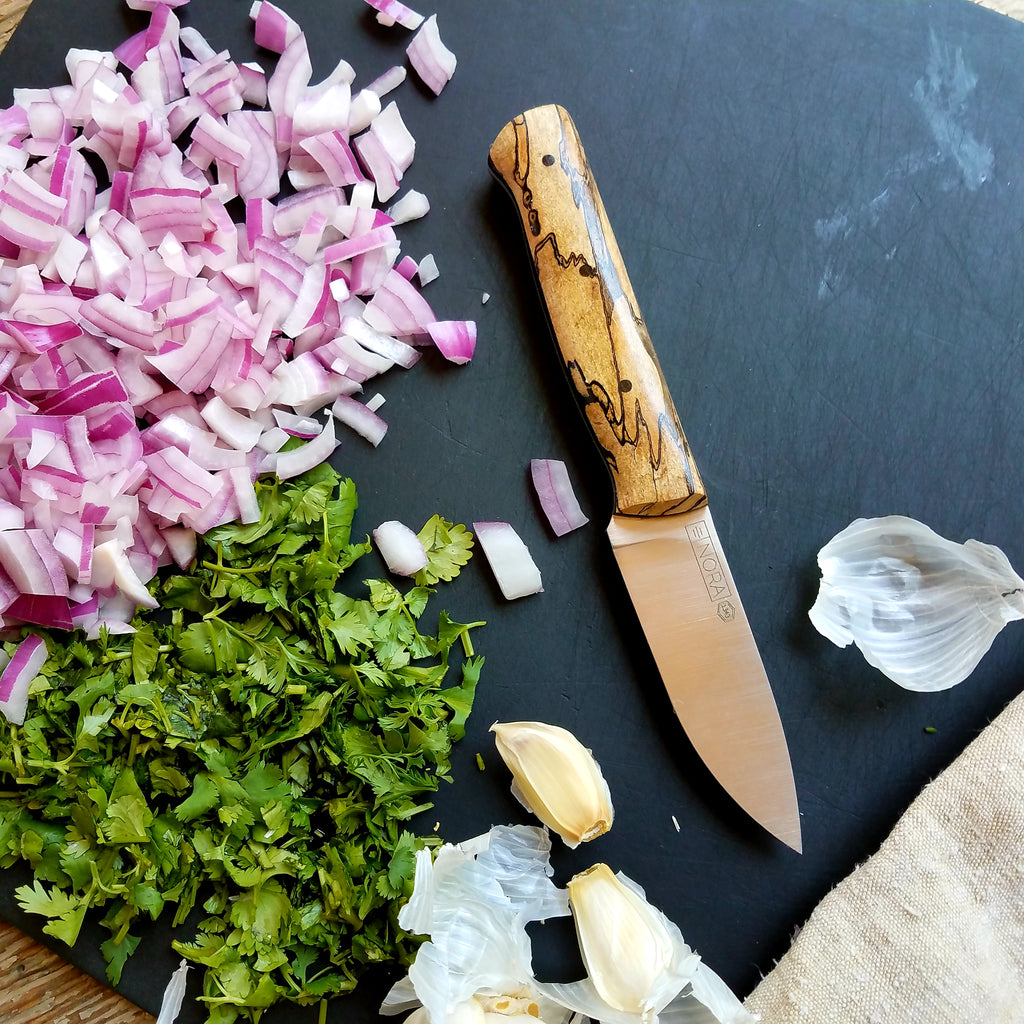
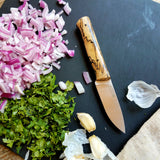
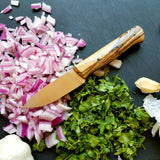
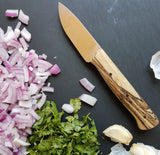
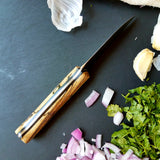
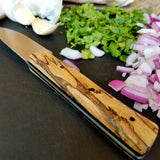
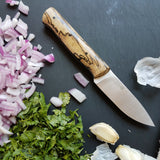
NORA #1343 - 3.5 Inch Chunky Paring - Highly Spalted Maple
$ 189.00
KNIFE HIGHLIGHTS
- Blade Type: Paring - Our Thicker Style
- Blade Length: 3.5 Inches
- Total Length: 8 Inches
- Handle Style: Western | Right or Left Hand Use
- Steel: AEB-L Stainless Steel
- Rockwell Hardness: 62 HRC
- Grind Type: Full Flat
- Handle Materials: Stabilized Spalted Maple, Black G10 Liners, Black Micarta Pins
- Thin for Performance (best performance but also more delicate)
- Thick for Durability (tough, built to last for heavier wear-n-tear)
- >>>Mid-Range with Special Geometry (specially ground for food release and glide but blade is kept slightly thicker for durability)
- Heavy in Hand (hefty, durable)
- Light (nimble, maneuverable)
- >>> Not too heavy, not too light (Mid-Range Weight)
GENERAL USES OF THIS KNIFE
The paring knife is often overlooked but the truth is it is one of the single most-used knives in the kitchen.
This blade style was our very first paring knife design and it has a chunkier handle and higher blade height than is usual for most paring knives. We eventually re-designed our paring to be a bit smaller and more nimble but this profile offers some unique flexibility as it can almost serve as a small utility style knife. ( It does for us at least!)
We use this profile pretty much every day for anything from cutting small vegetables, spreading peanut butter and even (cough) opening boxes. In particular, we have also found that this knife also works quite well for skinning and removing animal fat. Its a very versatile little knife and we thought we would make a few of this style as we have really grown to love this one in our own kitchen.
HANDLE DESIGN & MATERIAL INFORMATION
Every one of our knives is handmade, unique and numbered. This lil' NORA is a simple and classic. Sometimes less really is better and that always seems to be the case for us when we are using spalted wood. Each piece of spalted wood is truly unique with different patterns, coloring and lines. We usually just leave it be and let the wood speak for itself.
This particular piece of wood is perhaps the most highly spalted piece that we have ever seen that is actually usable. As you may know, spalted wood is any form of discoloration or lines produced by fungi. It's essentially rotted wood. Even more interesting is the fact that the black "zone lines" in the wood represent competing forms of fungi setting up barriers to prevent other fungi from invading their territory. As you can see from this piece, it looks like it was basically Armageddon for the fungi on this small piece of wood.
Before stabilization, the wood is usually light and punky and not fit for use which is why it is frequently thrown out by mills. In the wood-working world, however, spalted wood is prized for all of the crazy variations and patterns and we fall into that fan group. Wood stabilization is an added feature that we offer with our knives and spalted wood, in particular, benefits greatly from stabilization. Wood that is stabilized has been injected with a clear acrylic resin under a vacuum process. Stabilization helps to minimize any cracking, warping, shrinkage and/or expanding of the material. Stabilized wood will not absorb water and is generally impervious to oils.
This piece, although not without some small flaws, is an absolutely stunning piece of wood. We hope you love it as much as we do. Please note, though, that virtually every piece of spalted wood will have some small voids and cracks. This is just the nature of spalted wood and if it concerns you, we don't suggest you purchase this knife You will find very fine cracks in your handle but you will also be able to notice that the stabilization fluid has filled into these areas making the wood incredibly durable. We let you know this only so that you have full disclosure up front. Some people don't like cracks. We understand. Personally, we love spalted wood but, again, we like to provide full disclosure up front so there are never any surprises with your purchase.
STEEL INFORMATION:
AEB-L STAINLESS STEEL
This knife blade is composed of AEB-L stainless steel which is a high-quality Swedish metal, originally developed for razor blades. Recently, steel suppliers have made this steel available in thicker sheets and it has proven to be an excellent adaptation for the cutlery industry.
AEB-L has a beautiful balance of carbon and chromium and, with proper heat treatment, this steel produces both a very fine edge as well as excellent toughness and edge stability. The fine grain structure also makes this steel very easy to sharpen. We believe it is one of the finest stainless steels available on the market today for use with kitchen knives.
As a side note, there are two things we like to mention about this steel:
1.) This steel responds beautifully to honing and if the knife is honed regularly it should need infrequent sharpening.
2.) AEB-L is a stainless steel but just barely. The concept of stainless steel is very misleading because every steel is, at some level, reactive to water and other elements. (It "stains". Just less than others.)
The higher carbon content in this stainless is what allows it to get a fine edge and higher hardness compared to many other stainless steels but it also has a tendency to sometimes form very fine rust spots on the blade. If this happens, these are easily removed with a green or red scotch brite pad and usually the rough end of a kitchen sponge will also do the trick. Take extra care to remove any excess wetness that remain on this blade. Drip drying is NOT recommended.
